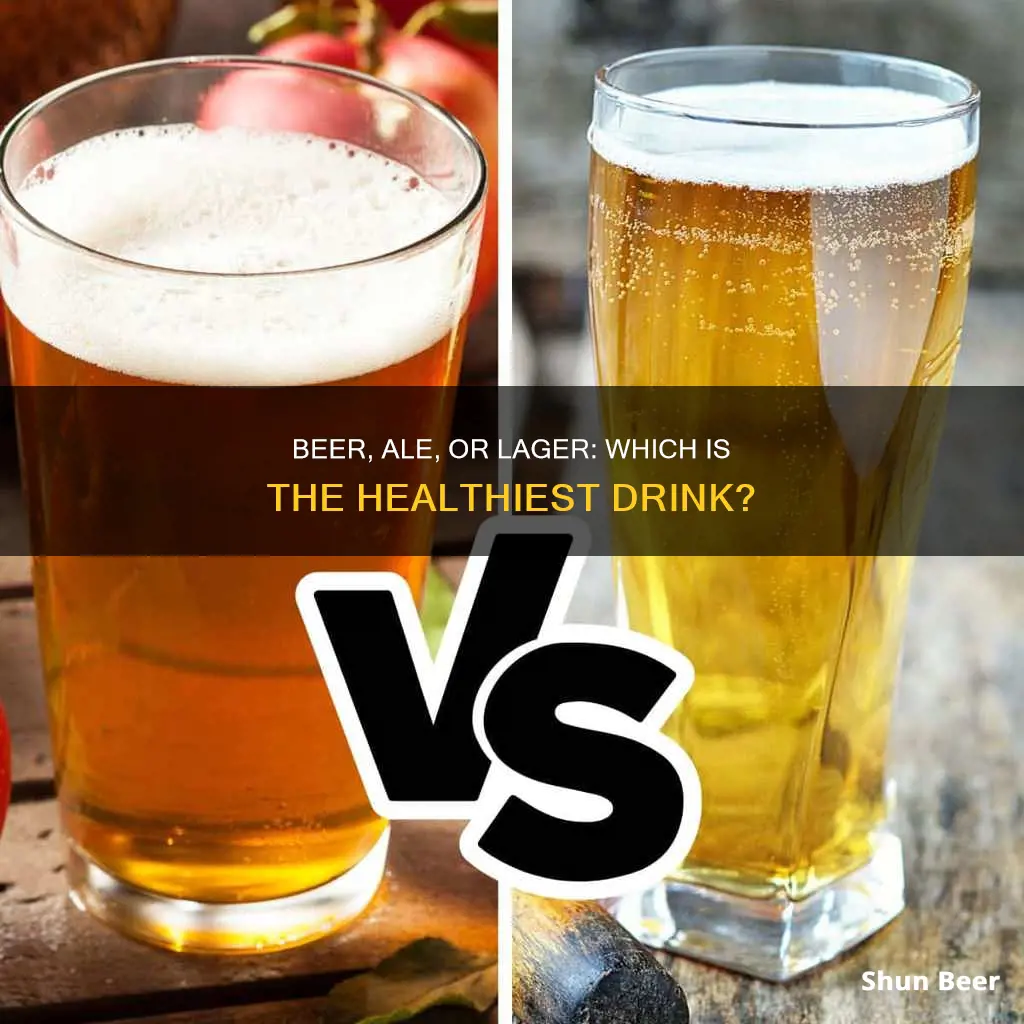
Ales and lagers are two of the most popular types of beer, but which is healthier? Ales typically have a higher concentration of phenols, natural antioxidants that can be found in many foods and are associated with heart health. Ales are also generally hopped more than lagers, which means they have about twice as many prenylflavonoids, another type of antioxidant. However, prenylflavonoids can act like the hormone estrogen, which can be unhealthy in large quantities. Lagers, on the other hand, tend to be lower in calories and carbohydrates, which may be beneficial for those watching their weight. Ultimately, both ales and lagers can be consumed in moderation as part of a healthy diet, but it's important to remember that excessive alcohol consumption can lead to negative health outcomes.
| Characteristics | Values |
|---|---|
| Phenol concentration | Ales have one of the highest phenol concentrations, which may also mean they have more heart-protecting compounds than other beers. |
| Calories | Ales such as Left Hand Good Juju are low in calories. |
| Alcohol content | Ales have a higher alcohol content than lagers. |
| Flavour | Ales are known to be bitter. |
| Health benefits | Ales are associated with a reduced risk of high blood pressure and heart disease. |
What You'll Learn
- Ales have one of the highest phenol concentrations, which may protect against heart disease
- Ales have more hops, which contain humulone, an antioxidant and anti-inflammatory
- Ales have more estrogenic prenylflavonoids, which are generally accepted as safe
- Ales are unfiltered, providing more dietary fibre
- Ales are served without the use of extraneous carbon dioxide

Ales have one of the highest phenol concentrations, which may protect against heart disease
Ales typically have one of the highest phenol concentrations among beers. Phenols are natural antioxidants that can be found in beer, wine, and brightly coloured fruits such as apples, oranges, and cranberries.
The phenols in beer come mostly from malt and hops. Malt, which usually comes from barley wheat, is a rich source of soluble fibre that helps lower LDL blood cholesterol in the body. Hops, on the other hand, make up about 30% of phenol content, while malt provides 70% to 80% of it. Ales contain more hops than other beers, so more flavonoids are extracted. Flavonoids give beer its dark colour and its antioxidant properties.
The health benefits of phenols in ales may include protection against heart disease. Research has shown that moderate beer drinkers (about a pint a day) have reduced their risk of heart diseases by 31% due to the alcohol. Ales also increase HDL, or "good cholesterol", in the body. In addition, the synergistic effect between alcohol and antioxidants in beer is good for the heart.
Beer's Natural Health Benefits: Fact or Fiction?
You may want to see also

Ales have more hops, which contain humulone, an antioxidant and anti-inflammatory
Humulone has been shown to suppress the expression of cyclooxygenase-2 (COX-2), an enzyme involved in prostaglandin biosynthesis and inflammation. COX-2 is often overexpressed in various pre-malignant and malignant tissues, and its inappropriate over-expression has been implicated in carcinogenesis. Humulone suppresses the transcriptional activation of COX-2 by inhibiting the activation of NF-κB and AP-1, two ubiquitous eukaryotic transcription factors. Humulone also inhibits the activation of upstream kinases, including IKK, ERK, and p38 MAPK, which are involved in the induction of COX-2 in TPA-stimulated mouse skin.
In addition to its anti-inflammatory effects, humulone has been found to inhibit bone resorption. This may be due to its ability to inhibit the catalytic activity of ERK1/2, a kinase involved in bone resorption. Overall, the presence of humulone in ales may contribute to their potential health benefits.
Unfiltered Beer: Healthier Choice or Marketing Ploy?
You may want to see also

Ales have more estrogenic prenylflavonoids, which are generally accepted as safe
Ales contain more estrogenic prenylflavonoids than lagers. Prenylflavonoids are a subclass of flavonoids with estrogen-like properties, and are found in hops and hop-derived products such as beers. The female flowers of the hop plant are used as a preservative and flavouring agent in beer.
The specific type of prenylflavonoid found in hops and beer is 8-prenylnaringenin, which has an estrogenic activity greater than other established plant estrogens. However, the levels of 8-prenylnaringenin in beer are low and are not considered a cause for concern.
In a study, a daily moderate intake of beer, with or without alcohol, was found to reduce menopausal discomforts in women going through the menopause transition. The effect of the intervention on the female sex hormone profile and cardiovascular risk factors was also monitored. The study found that the sex hormone profile did not differ significantly between the study groups, and the effects of both types of beers (with and without alcohol) are attributed to the non-alcoholic fraction of beer. Furthermore, moderate non-alcoholic beer consumption improved the lipid profile and decreased blood pressure in postmenopausal women.
Sapporo Beer: Healthy Choice or Not?
You may want to see also

Ales are unfiltered, providing more dietary fibre
Ales are unfiltered and provide more dietary fibre than lagers. Dietary fibre is found in the indigestible parts of cereals, fruits and vegetables. It is mainly a carbohydrate and is essential to keeping the digestive system healthy.
There are two categories of fibre: soluble and insoluble. Soluble fibre soaks up water, helping to bulk out our faeces so that they can pass through the gut more easily. Insoluble fibre, on the other hand, does not absorb water and speeds up the time that food passes through the gut. It adds bulk to faeces and prevents constipation and associated problems such as haemorrhoids.
A diet high in fibre has been linked to a reduced risk of constipation, irritable bowel syndrome (IBS), diverticulitis, heart disease and some cancers. It can also help with weight control, stabilising glucose levels, and reducing the risk of other conditions such as type 2 diabetes.
By not filtering ales, more of the indigestible fibre from the barley and other grains remains in the beer. This means that ales can provide more of the health benefits associated with dietary fibre than lagers.
Apple Ale vs Beer: Which is the Healthier Choice?
You may want to see also

Ales are served without the use of extraneous carbon dioxide
The natural carbonation of real ales is retained due to the ongoing slow process of secondary fermentation. This continues in the cask or bottle on the way to the consumer, keeping the beer fresh. Real ales are typically dispensed by handpump, or "by gravity" directly from the cask. They can also be dispensed using electric pumps, especially in the Midlands and Scotland.
The use of a cask breather can extend the beer's saleable life by adding carbon dioxide to the cask to replace the beer as it is drawn off. However, the added gas is not at a high pressure, distinguishing it from keg beer.
The term "real ale" was coined in the 1970s by the Campaign for Real Ale (CAMRA) to attract media attention in the UK. At that time, there were very few independent breweries, and most production had shifted to filtered and pasteurised ales served under carbon dioxide pressure ("keg beer"). Despite the historical shift towards keg beer, cask-conditioned ale remains popular in the UK, particularly in traditional pubs. In 2019, 420 million pints of cask ale were sold in the UK, accounting for 13.5% of all pints.
Gorton's Beer Battered Fish: Healthy or Harmful?
You may want to see also
Frequently asked questions
All beers tend to contain some health benefits, but some styles of beer will provide more benefits than others. Ales typically have one of the highest phenol concentrations, which may also pack in more heart-protecting compounds than other beers. However, darker beers such as stouts and porters are also considered to be some of the healthiest beers.
Beer contains antioxidants, minerals, and vitamins, including several important nutrients that are most easily digestible in beer form. Light to moderate consumption of beers is associated with the prevention of type-2 diabetes, osteoporosis, coronary heart disease, hypertension, dementia, and many types of cancer.
While drinking a low to moderate amount of beer may have health benefits, drinking excessively can lead to alcoholism and depression. Alcohol also raises the risk of multiple cancers as well as heart and liver disease.
Some examples of healthier beers include Guinness, Newcastle Brown Ale, London Porter Dark Ale, and several Belgian beers such as Hoegaarden, Westmalle Tripel, and Echt Kriekenbier.







